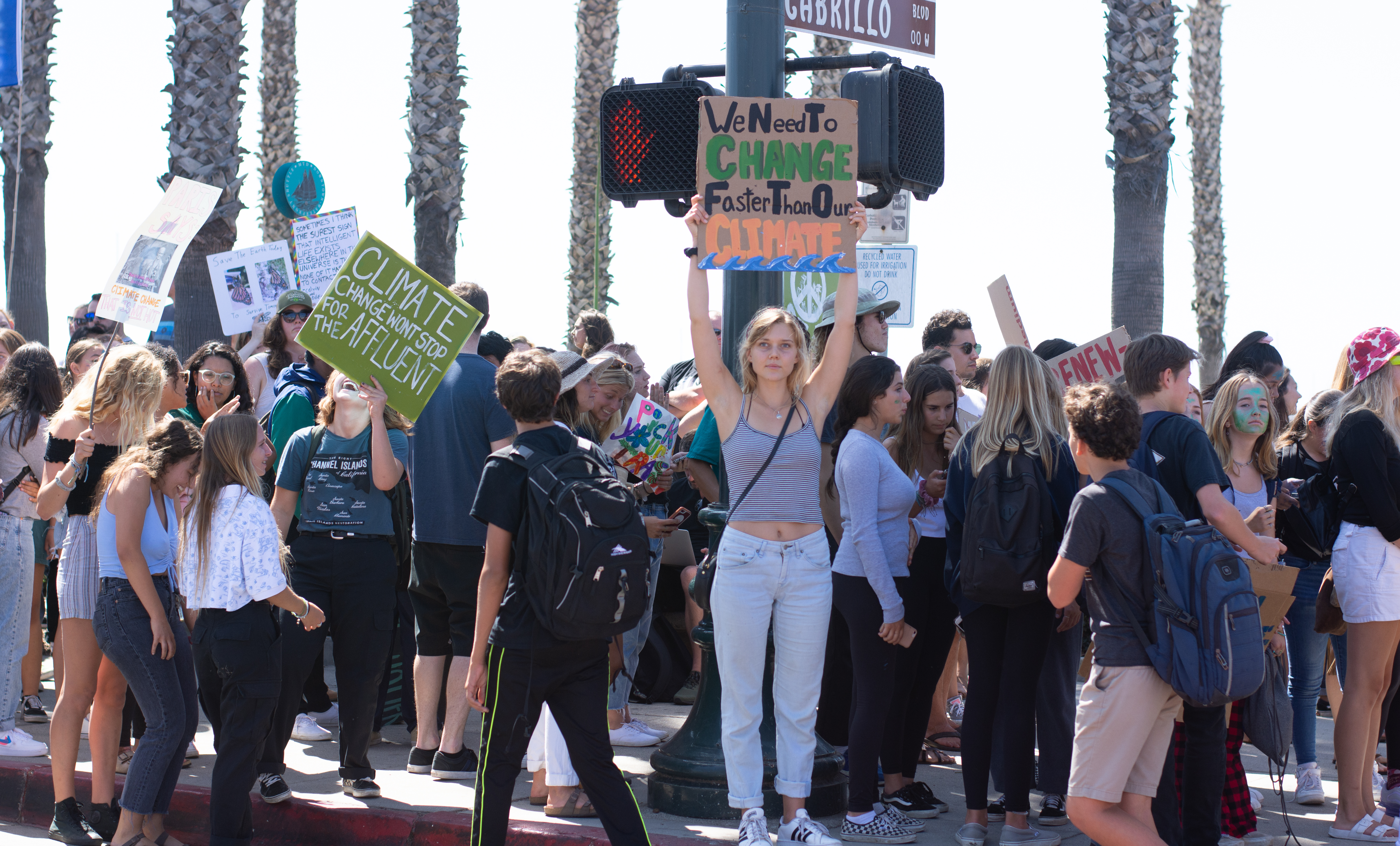‘It’s Going to Happen to Us’
Harms from Climate Change Fall to the Young, They Strike for Positive Change

The great movement of young people striking for climate action around the globe brought more than a thousand people to downtown Santa Barbara’s De la Guerra Plaza last Friday, with a second Climate Strike rallying this Friday at noon. Inspired by the example of a Swedish 16-year-old, Greta Thunberg, who first sailed to North America from Europe, then castigated world leaders assembled at the United Nations on Monday for betraying her generation, the strikers demanded a change for the better.
“Change is coming, whether we like it or not,” said Brent Goodlet, an organizer for the September 27 rally and a materials engineering postdoc at UCSB. “What I fear is that we will lose this green beauty that is Santa Barbara. This wonderful climate that harbors a wonderful city will dry out as climate zones shift northward. When the next forest fire comes through, it will not regrow the way it was because the middle latitudes are growing hotter and drier.”
Thunberg, whose every word was urgent, chastised the UN members gathered for a Climate Summit, asking, “How dare you pretend that this can be solved with just business as usual?” Thunberg said climate change science has been “crystal clear” for more than 30 years, but leaders preferred the “fairy tales of eternal economic growth.”
With that in mind, the organizers of Dos Pueblos High School’s walkout last Friday pushed county supervisors for a moratorium on all future oil projects and for a Green New Deal to transition oil workers into other jobs. One organizer, student Coraline Crannell, spoke of the urgency for a freeze, explaining the Intergovernmental Panel on Climate Change’s 2018 special report had made it “frighteningly obvious that climate change is a direct threat to our global ecosystem that needs to be addressed immediately.”
In her UN speech, Thunberg also referred to the study, criticizing the promise by some countries to cut carbon emissions in half by 2030, even though there was just a 50 percent chance this would keep temperature rise below the critical threshold of 1.5 degrees Celsius. Failure meant an irreversible chain reaction beyond human control. The carbon dioxide budget in the report has now dropped from 420 gigatons to 350 gigatons: “That remaining CO2 budget will be entirely gone within less than eight and a half years,” she said.
Thunberg, who would only be 24 years old by then, promised the General Assembly: “We will not let you get away with this.”

Evan Sherman, of Santa Barbara High School’s Green Club, agreed, saying, “We only have one future, and it’s important that we fight for it.” He helped organize last week’s downtown march, in which about 200 students walked off campus holding signs painted on used cardboard, joined by hundreds more as they marched to Stearns Wharf and back to De la Guerra Plaza. “The world was watching us,” he noted. “I sure hope this spurs action. We’ve all got to work to minimize our carbon footprint.” On a personal level, Sherman said he’s a vegetarian: “It’s the biggest way to minimize your personal impact, especially minimizing red meat. A lot of resources go into your hamburger,” he said.
At City College, co-president of the Biology Club Sophie Cameron spoke starkly: “We may not have a normal future.” She had brought a pair of corn snakes to the tables to represent all the species in danger: “We may not be able to have kids, or jobs.” Other students said they worried whether they should take a gap year while resources were still available and whether they should stay in school for a master’s degree. Cameron’s club co-president, Rebecca Adam, observed, “If anything is going to happen with climate change, it’s going to happen to us.”
“We’re living on borrowed time,” Goodlet said. He noted that island nations were being inundated already, as are U.S. coastal areas like Florida, while 40 percent of people worldwide lived along coastlines. The changes that were causing giant wildfires and ocean flooding would ultimately affect food production and air and water quality. “There are so many positives to taking action now,” he said, “and no real benefit to delaying.”
And it was an issue all could respond to: looking after the land and the environment has always been a conservative ethic, Goodlet noted. Richard Nixon created the Environmental Protection Agency, after all. Government action was needed on “big ticket” items, he said, such as the 67 percent of U.S. emissions that come from burning fossil fuels. California’s clean energy standards have convinced the auto industry speed up the transition to alternative-energy vehicles. “It’s true that habits need to change,” Goodlet observed, “but we don’t need to stop eating hamburgers or stop driving cars. Green technologies exist, and they create green jobs.”
The exception to green tech so far has been jet fuel, he added, which faced the physical challenges of battery weight and flight. And you probably wouldn’t want to put a giant windmill amid an endangered bird habitat, he commented, but huge swaths of earth were available for wind and tidal resources.
“Whether we want to believe it or not,” Goodlet said, “we’re entering the sixth extinction event in this planet’s history,” an existential fight well understood by youth activists. When 3 to 4 percent of a voting population actively advocates for a policy, he noted, “You can typically win the day.”
Youth activism is a huge change, Goodlet said. “It’s a huge reason for hope.”




You must be logged in to post a comment.